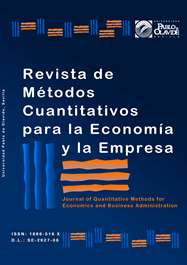Master Production Scheduling Based on Integer Linear Programming for a Chemical Company
DOI:
https://doi.org/10.46661/revmetodoscuanteconempresa.2885Keywords:
planificación de la producción, plan maestro de producción (PMP), programación lineal entera, industria química, production planning, master production scheduling (MPS), integer linear programming, chemical industryAbstract
In this work, we propose an integer linear programming model for production scheduling of a group of finished products with independent demand. The model for the master production scheduling (MPS) is designed by considering production and inventory costs, as well as the productive process constraints regarding installations and production times. The aim of the proposed model is the minimization of the costs involved; specifically, undertime and overtime costs of resources, as well as the consideration of a minimum service level related to the deferred demand. The validation of the model considers data belonging to the demand of each product in a 12-week planning horizon and compares five scenarios in which some characteristics of the system and different service levels are modified. Finally, the results obtained for each one of the scenarios expose the improvement obtained by the proposed model with regard to the current procedure in the studied company.
Downloads
References
Boiteux, O.D.; Corominas, A. y Lusa, A. (2007): “Estado del arte sobre planificación agregada de la producción”. Enginyeria d’Organització i Logística Industrial, 4(2), 1–39.
Brandenburg, M. y Tölle, F.J. (2009): “MILP-based campaign scheduling in a speciality chemicals plant: a case study”. OR Spectrum, 31, 141–166.
Buschkühl, L.; Sahling, F.; Helber, S. y Tempelmeier, H. (2010): “Dynamic capacitated lot-sizing problems: A classification and review of solution approaches”. OR Spectrum, 32, 231–261.
Díaz-Madroñero, M.; Mula, J. y Peidro, D. (2014): “A review of discrete-time optimization models for tactical production planning”. International Journal of Production Research, 52(17), 5171–5205.
Dzielinski, B.P. y Gomory, R.E. (1965): “Optimal programming of lot sizes, inventory and labor allocations”. Management Science, 11(9), 874–890.
Escobar, P.; Giraldo, J.A. y Cárdenas, D.M. (2012): “Programación de sistemas de producción híbridos, para inventario/bajo pedido, mediante un proceso analítico jerárquico de ordenación grupal (GAHPO) ”. Información Tecnológica, 23(5), 33–46.
Flores, B.E. y Whybark, D.C. (1986): “Multiple criteria ABC analysis”. International Journal of Operations and Production Management, 6(3), 38–46.
Grunow, M.; Günther, H. O. y Lehmann, M. (2002): “Campaign planning for multi-stage batch processes in the chemical industry”. OR Spectrum, 24, 281–314.
Hax, A.C. y Meal, H.C. (1975): “Hierarchical integration of production planning and scheduling”. En M.A. Geisler (ed.): TIMS Studies in Management Sciences, Volume 1: Logistics. Nueva York: North Holland/American Elsevier, pp. 53–69.
Lasdon, L.S. y Terjung, R.C. (1971): “An efficient algorithm for multi-item scheduling”. Operations Research, 19, 946–969.
Mangiameli, P.M. (1979): The effects of managerial policies on aggregate plans, the master production schedule, and departmental plans. Tesis doctoral, Ohio: Ohio State University.
Moniz, S.; Barbosa-Póvoa, A.P. y de Sousa, J.P. (2014): “Simultaneous regular and non-regular production scheduling of multipurpose batch plants: A real chemical-pharmaceutical case study”. Computers and Chemical Engineering, 67, 83–102.
Mula, J.; Lyons, A.C.; Hernández, J.E. y Poler, R. (2014): “An integer linear programming model to support customer-driven material planning in synchronised, multi-tier supply chains”. International Journal of Production Research, 52(14), 4267–4278.
Mula, J.; Poler, R. y García, J.P. (2006a): “MRP with flexible constraints: A fuzzy mathematical programming approach”. Fuzzy Sets and Systems, 157(1), 74–97.
Mula, J.; Poler, R.; García-Sabater, G.S. y Lario, F.C. (2006b): “Models for production planning under uncertainty: A review”. International Journal of Production Economics, 103(1), 271–285.
Osorio, J.C. y Motoa, T.G. (2008): “Planificación jerárquica de la producción en un job shop flexible”. Revista Facultad de Ingeniería Universidad de Antioquía, 44, 158–171.
Portela, R.V. (2007): “La planeación y programación de la producción en la pyme”. AVANCES. Investigación en Ingenieria, 6(6), 40–57.
Quadt, D. y Kuhn, H. (2008): “Capacitated lot-sizing with extensions: A review”. 4OR, 6(1), 61–83.
Till, J.; Sand, G.; Urselmann, M. y Engell, S. (2007): “A hybrid evolutionary algorithm for solving two-stage stochastic integer programs in chemical batch scheduling”. Computers and Chemical Engineering, 31(5-6), 630–647.
Ul Hassan, M. y Stockhammar, P. (2016): “Fitting probability distributions to economic growth: a maximum likelihood approach”. Journal of Applied Statistics, 43(9), 1583–1603.
Venkataraman, R. y Nathan, J. (1994): “Master Production Scheduling for a Process Industry Environment: A Case Study”. International Journal of Operations and Production Management, 14(10), 44–53.
Downloads
Published
How to Cite
Issue
Section
License
Copyright (c) 2017 Journal of Quantitative Methods for Economics and Business Administration

This work is licensed under a Creative Commons Attribution-ShareAlike 4.0 International License.
Submission of manuscripts implies that the work described has not been published before (except in the form of an abstract or as part of thesis), that it is not under consideration for publication elsewhere and that, in case of acceptance, the authors agree to automatic transfer of the copyright to the Journal for its publication and dissemination. Authors retain the authors' right to use and share the article according to a personal or instutional use or scholarly sharing purposes; in addition, they retain patent, trademark and other intellectual property rights (including research data).
All the articles are published in the Journal under the Creative Commons license CC-BY-SA (Attribution-ShareAlike). It is allowed a commercial use of the work (always including the author attribution) and other derivative works, which must be released under the same license as the original work.
Up to Volume 21, this Journal has been licensing the articles under the Creative Commons license CC-BY-SA 3.0 ES. Starting from Volume 22, the Creative Commons license CC-BY-SA 4.0 is used.










